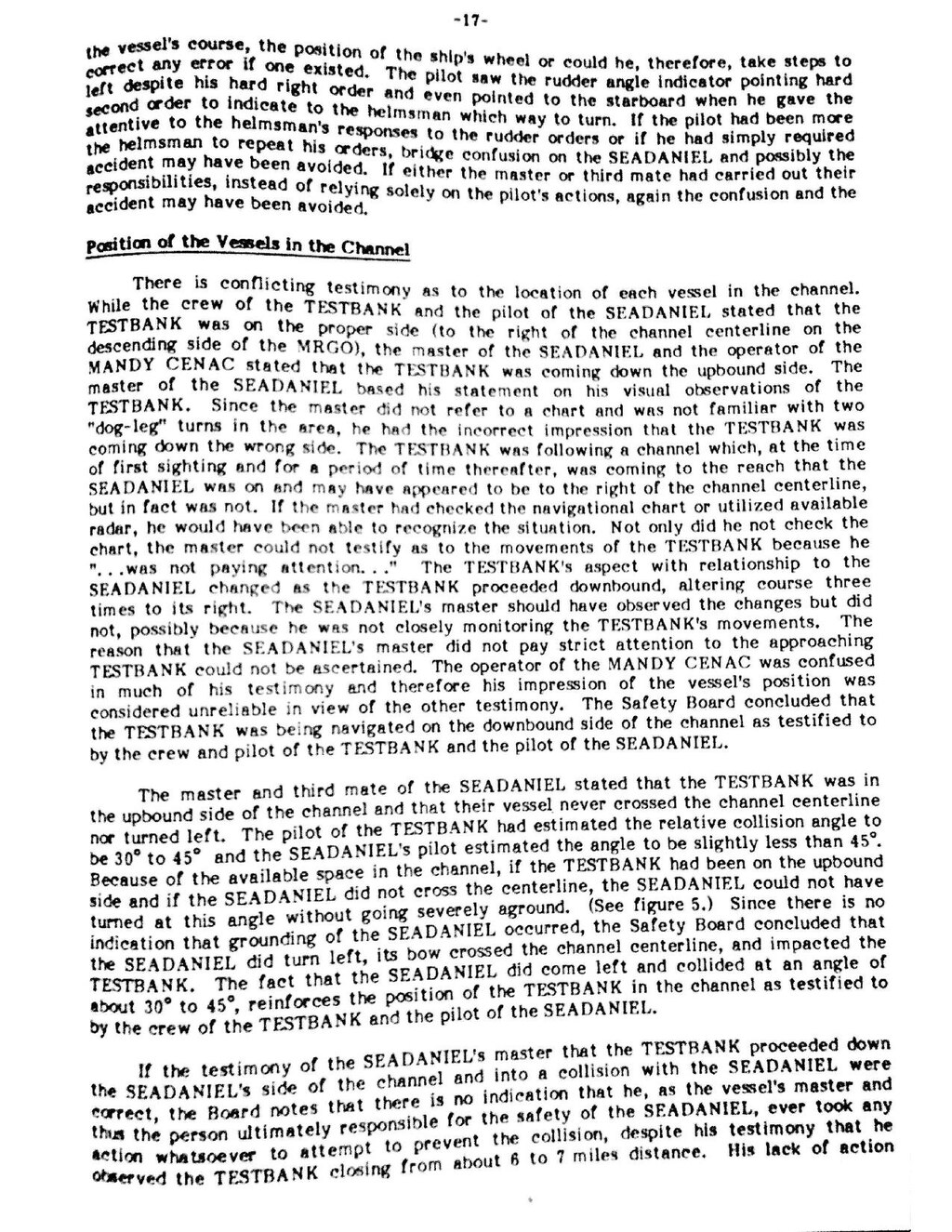the vessel's course, the position of the ship's wheel or could he, therefore, take steps to correct any error if one existed. The pilot saw the rudder angle indicator pointing hard left despite his hard right order and even pointed to the starboard when he gave the second order to indicate to the helmsman which way to turn. If the pilot had been more attentive to the helmsman's responses to the rudder orders or if he had simply required the helmsman to repeat his orders, bridge confusion on the Seadaniel and possibly accident may have been avoided. If either the master or third mate had carried out their responsibilities, instead of relying solely on the pilot's actions, again the confusion and the accident may have been avoided.
Position of the Vessels in the Channel
There is conflicting testimony as to the location of each vessel in the channel. While the crew of the Testbank and the pilot of the Seadaniel stated that the Testbank was on the proper side (to the right of the channel centerline on the descending side of the MRGO), the master of the Seadaniel and the operator of the Mandy Cenac stated that the Testbank was coming down the upbound side. The master of the Seadaniel based his statement on his visual observations of the Testbank. Since the master did not refer to a chart and was not familiar with two "dog-leg" turns in the area, he had the incorrect impression that the Testbank was coming down the wrong side. The Testbank was following a channel which, at the time of first sighting and for a period of time thereafter, was coming to the reach that the Seadaniel was on and may have appeared to be to the right of the channel centerline, but in fact was not. If the master had checked the navigational chart or utilized available radar, he would have been able to recognize the situation. Not only did he not check the chart, the master could not testify as to the movements of the Testbank because he "…was not paying attention…" The Testbank's aspect with relationship to the Seadaniel changed as the Testbank proceeded downbound, altering course three times to the right. The Seadaniel's master should have observed the changes but did not, possibly because he was not closely monitoring the Testbank's movements. The reason that the Seadaniel's master did not pay strict attention to the approaching Testbank could not be ascertained. The operator of the Mandy Cenac was confused in much of his testimony and therefore his impression of the vessel's position was considered unreliable in view of the other testimony. The Safety Board concluded that the Testbank was being navigated on the downbound side of the channel as testified to by the crew and pilot of the Testbank and the pilot of the Seadaniel.
The master and third mate of the Seadaniel stated that the Testbank was in the upbound side of the channel and that their vessel never crossed the channel centerline nor turned left. The pilot of the Testbank had estimated the relative collision angle to be 30º to 45º and the Seadaniel's pilot estimated the angle to be slightly less than 45º. Because of the available space in the channel, if the Testbank had been on the upbound side and if the Seadaniel did not cross the centerline, the Seadaniel could not have turned at this angle without going severely aground. (See figure 5.) Since there is no indication that grounding of the Seadaniel occurred, the Safety Board concluded that the Seadaniel did turn left, its bow crossed the channel centerline, and impacted the Testbank. The fact that the Seadaniel in the channel as testified to by the crew of the Testbank and the pilot of the Seadaniel.
If the testimony of the Seadaniel's master that the Testbank proceeded down the Seadaniel's side of the channel and into a collision with the Seadaniel were correct, the Board notes that there is no indication that he, as the vessel's master and that the person ultimately responsible for the safety of the Seadaniel, ever took any action whatsoever to attempt to prevent the collision, despite his testimony that he observed the Testbank closing from about 6 to 7 miles distance. His lack of action
